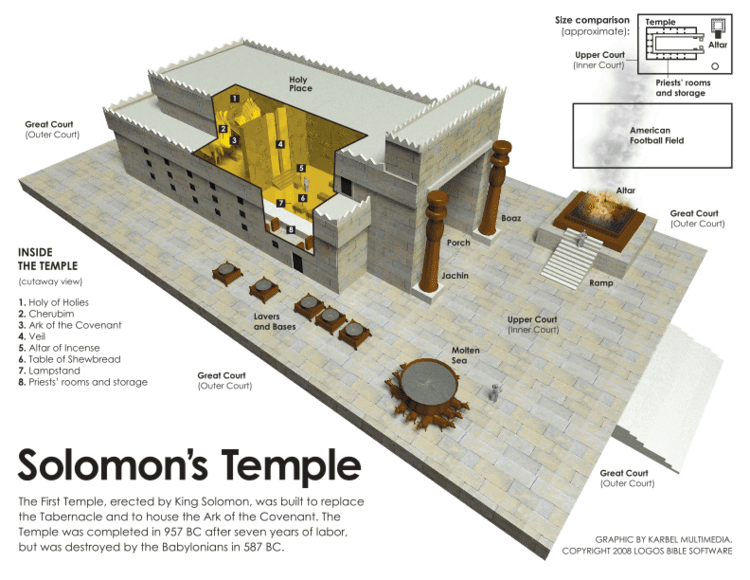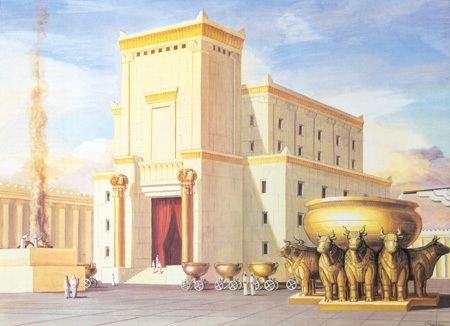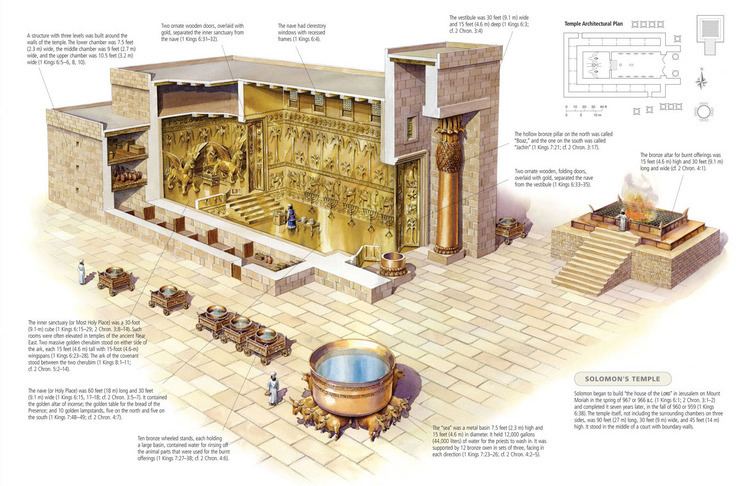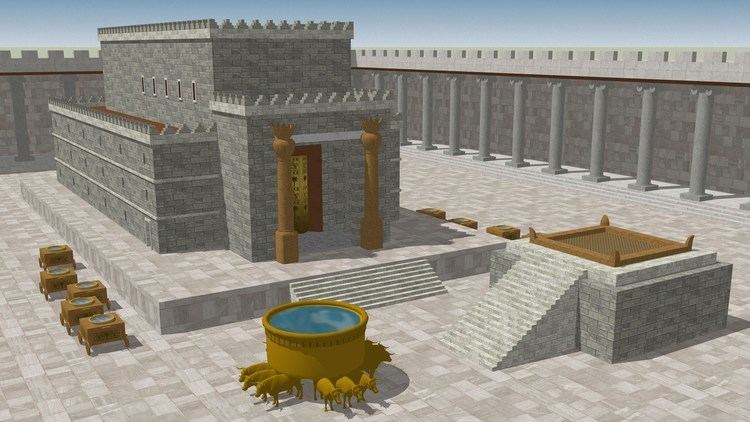 | ||
Solomon s temple
According to the Hebrew Bible, Solomon's Temple, also known as the First Temple, was the Holy Temple (Hebrew: בֵּית־הַמִּקְדָּשׁ: Beit HaMikdash) in ancient Jerusalem before its destruction by Nebuchadnezzar II after the Siege of Jerusalem of 587 BCE and its subsequent replacement with the Second Temple in the 6th century BCE.
Contents
- Solomon s temple
- In the Hebrew Bible
- Architectural description
- Holy of Holies
- Hekhal
- Porch
- Chambers
- Courts
- Brazen Sea
- Archaeology
- Other contemporary temples
- Freemasonry
- Kabbalah
- References

The Hebrew Bible states that the temple was constructed under Solomon, king of the United Kingdom of Israel and Judah and that during the Kingdom of Judah, the temple was dedicated to Yahweh, and is said to have housed the Ark of the Covenant. Jewish historian Josephus says that "the temple was burnt four hundred and seventy years, six months, and ten days after it was built", although rabbinic sources state that the First Temple stood for 410 years and, based on the 2nd-century work Seder Olam Rabbah, place construction in 832 BCE and destruction in 422 BCE, 165 years later than secular estimates.

Because of the religious sensitivities involved, and the politically volatile situation in Jerusalem, only limited archaeological surveys of the Temple Mount have been conducted. No archaeological excavations have been allowed on the Temple Mount during modern times. Therefore, there are very few pieces of archaeological evidence for the existence of Solomon's Temple. An Ivory pomegranate which mentions priests in the house "of ---h", and an inscription recording the Temple's restoration under Jehoash have both appeared on the antiquities market, but their authenticity has been challenged and they are the subject of controversy.

In the Hebrew Bible

The only source of information on the First Temple is the Hebrew Bible, which is the base for the Old Testament. According to the biblical sources, the temple was constructed under Solomon, during the united monarchy of Israel and Judah. The Bible describes a Hiram I of Tyre who furnished architects, workmen and cedar timbers for the temple of his ally Solomon at Jerusalem. He also co-operated with Solomon in mounting an expedition on the Red Sea. 1 Kings 6:1 puts the date of the beginning of building the temple "in the fourth year of Solomon's reign over Israel". The conventional dates of Solomon's reign are circa 970 to 931 BCE. This puts the date of its construction in the mid-10th century BCE. Some scholars have speculated that a Jebusite sanctuary may have previously occupied the site. 1 Kings 9:10 says that it took Solomon 20 years altogether to build the Temple and his royal palace. The Temple itself finished being built after 7 years. During the united monarchy the Temple was dedicated to Yahweh, the God of Israel, and housed the Ark of the Covenant. Rabbinic sources state that the First Temple stood for 410 years and, based on the 2nd-century work Seder Olam Rabbah, place construction in 832 BCE and destruction in 422 BCE (3338 AM), 165 years later than secular estimates.

The exact location of the Temple is unknown: it is believed to have been situated upon the hill which forms the site of the 1st century Second Temple and present-day Temple Mount, where the Dome of the Rock is situated.

According to the Hebrew Bible, the Temple was plundered by the Neo-Babylonian Empire king Nebuchadnezzar II when the Babylonians attacked Jerusalem during the brief reign of Jehoiachin c. 598 (2 Kings 24:13). A decade later, Nebuchadnezzar again besieged Jerusalem and after 30 months finally breached the city walls in 587 BCE, subsequently burning the Temple, along with most of the city (2 Kings 25). According to Jewish tradition, the Temple was destroyed on Tisha B'Av, the 9th day of Av (Hebrew calendar).
Architectural description
The Temple of Solomon is considered to be built according to Phoenician design, and its description is considered the best description of what a Phoenician temple looked like. The detailed descriptions provided in the Tanakh are the sources for reconstructions of its appearance. Technical details are lacking, since the scribes who wrote the books were not architects or engineers. Nevertheless, the descriptions have inspired modern replicas of the temple and influenced later structures around the world.
Reconstructions differ; the following is largely based on Easton's Bible Dictionary and the Jewish Encyclopedia:
Holy of Holies
The Holy of Holies, or Kodesh haKodashim in Hebrew, (1 Kings 6:19; 8:6), also called the "Inner House" (6:27), (Heb. 9:3) was 20 cubits in length, breadth, and height. The usual explanation for the discrepancy between its height and the 30-cubit height of the temple is that its floor was elevated, like the cella of other ancient temples. It was floored and wainscotted with cedar of Lebanon (1 Kings 6:16), and its walls and floor were overlaid with gold (6:20, 21, 30). It contained two cherubim of olive-wood, each 10 cubits high (1 Kings 6:16, 20, 21, 23–28) and each having outspread wings of 10 cubits span, so that, since they stood side by side, the wings touched the wall on either side and met in the center of the room. There was a two-leaved door between it and the Holy Place overlaid with gold (2 Chr. 4:22); also a veil of tekhelet (blue), purple, and crimson and fine linen (2 Chronicles 3:14; compare Exodus 26:33). It had no windows (1 Kings 8:12) and was considered the dwelling-place of the "name" of God. Kodesh haKodashim (the Holy of Holies) was prepared to receive and house the Ark (1 Kings 6:19); and when the Temple was dedicated, the Ark, containing the original tablets of the Ten Commandments, was placed therein (1 Kings 8:6-9). When the priests emerged from the holy place after placing the Ark there, the Temple was filled with a cloud, "for the glory of the Lord had filled the house of the Lord" (1 Kings 8:10-11; 2 Chronicles 5:13, 14).
Hekhal
The Hekhal, or Holy Place, (1 Kings 8:8–10), is also called the "greater house" (2 Chr. 3:5) and the "temple" (1 Kings 6:17); the word also means "palace", was of the same width and height as the Holy of Holies, but 40 cubits in length. Its walls were lined with cedar, on which were carved figures of cherubim, palm-trees, and open flowers, which were overlaid with gold. Chains of gold further marked it off from the Holy of Holies. The floor of the Temple was of fir-wood overlaid with gold. The door-posts, of olive-wood, supported folding-doors of fir. The doors of the Holy of Holies were of olive-wood. On both sets of doors were carved cherubim, palm-trees, and flowers, all being overlaid with gold (1 Kings 6:15 et seq.)
Etymology
The Hebrew noun hekhal (Hebrew היכל) in Classical Hebrew means "a large building". This can be either the main building of the Temple in Jerusalem (that is the nave, or sanctuary, of the Temple), or a palace such as the "palace" of Ahab, king of Samaria, or the "palace" of the King of Babylon.
Hekhal is used 80 times in the Masoretic Text of the Hebrew Bible. Of these, 70 refer to the House of the LORD (in Hebrew Bible בֵּית יְהוָה beit Yahweh), the other 10 are references to palaces. There is no reference to any part of the tabernacle using this term in the Hebrew Bible.
"In the year that king Uzziah died. I saw the LORD sitting upon a throne high and lifted up, and His train filled the hekhal (sanctuary)." Isaiah 6:1.
Use in architecture
In older English versions of the Bible, including the King James Version, the term "temple" is used to translate hekhal. In modern versions more reflective of archaeological research, the distinction is made of different sections of the whole Temple. Scholars and archaeologists generally agree on the structure of Solomon's Temple as described in 1 Kings 6:3-5, with the main building, the hekhal, in English now sometimes called "the sanctuary," the devir, the inner sanctuary, and finally the Holy of Holies.
This main building was between the outer altar, where most sacrifices were performed, and inside at the far end was the entry to the Holy of Holies, originally containing the Ark of the Covenant. The main hekhal contained a number of sacred ritual objects including the seven branched candlestick, the inner altar for incense offerings (also called the "Golden Altar"), and the table of the showbread.
The same architectural layout of the temple was adopted in synagogues leading to the hekhal being applied in Sephardi usage to the Ashkenazi Torah ark, the equivalent of the nave.
Porch
The Ulam, or porch, acted as an entrance before the Temple on the east (1 Kings 6:3; 2 Chr. 3:4; 9:7). This was 20 cubits long (corresponding to the width of the Temple) and 10 cubits deep (1 Kings 6:3). (ESV 2 Chr. 3:4) notes that this porch was 120 cubits high. The description does not specify whether a wall separated it from the next chamber. In the porch stood the two pillars Jachin and Boaz (1 Kings 7:21; 2 Kings 11:14; 23:3), which were 18 cubits in height.
Chambers
Chambers were built around the Temple on the southern, western and northern sides (1 Kings 6:5–10). These formed a part of the building and were used for storage. They were probably one story high at first; two more may have been added later.
Courts
According to the Bible, two courts surrounded the Temple. The Inner Court (1 Kings 6:36), or Court of the Priests (2 Chr. 4:9), was separated from the space beyond by a wall of three courses of hewn stone, surmounted by cedar beams (1 Kings 6:36). It contained the Altar of burnt-offering (2 Chr. 15:8), the Brazen Sea laver (4:2–5, 10) and ten other lavers (1 Kings 7:38, 39). A brazen altar stood before the Temple (2 Kings 16:14), its dimensions 20 cubits square and 10 cubits high (2 Chr. 4:1). The Great Court surrounded the whole Temple (2 Chr. 4:9). It was here that people assembled to worship. (Jeremiah 19:14; 26:2).
Brazen Sea
The large basin known as the "Brazen Sea" measured 10 cubits wide brim to brim, 5 cubits deep and with a circumference of 30 cubits around the brim, rested on the backs of twelve oxen (1 Kings 7:23–26). The Book of Kings states that it contains 2,000 baths (90 cubic meters, while Chronicles (2 Chr. 4:5–6) states it can hold up to 3,000 baths (136 cubic meters) and states that its purpose was to afford opportunity for the purification by immersion of the body of the priests.
The lavers, each of which held "forty baths" (1 Kings 7:38), rested on portable holders made of bronze, provided with wheels, and ornamented with figures of lions, cherubim, and palm-trees. The author of the books of the Kings describes their minute details with great interest (1 Kings 7:27–37). Josephus reported that the vessels in the Temple were composed of orichalcum in Antiquities of the Jews. According to 1 Kings 7:48 there stood before the Holy of Holies a golden altar of incense and a table for showbread. This table was of gold, as were also the five candlesticks on each side of it. The implements for the care of the candles–tongs, basins, snuffers, and fire-pans–were of gold; and so were the hinges of the doors.
Archaeology
Because of the religious and political sensitivities involved, no archaeological excavations and only limited surface surveys of the Temple Mount have been conducted since Charles Warren's expedition of 1867–70. There is no archaeological evidence for the existence of Solomon's Temple, and the building is not mentioned in surviving extra-biblical accounts. Israel Finkelstein and Neil Asher Silberman argue that the first Jewish temple in Jerusalem was not built until the end of the 7th century BCE, around three hundred years after Solomon. They believe the temple should not really be assigned to Solomon, who they see as little more than a small-time hill country chieftain, and was most likely built by Josiah, who governed Judah from 639-609 BCE.
Other contemporary temples
There is archaeological and written evidence of three Israelite temples, either contemporary or of very close date, dedicated to Yahweh (Elephantine temple, probably Arad too), either in the Land of Israel or in Egypt. Two of them have the same general outline as given by the Bible for the Jerusalem Temple.
Freemasonry
Rituals in Freemasonry refer to King Solomon and the building of his Temple. Masonic buildings, where Lodge members meet, are sometimes called 'temples'; an allegoric reference to King Solomon's Temple.
Kabbalah
Kabbalah views the design of the Temple of Solomon as representative of the metaphysical world and the descending light of the creator through Sephirot of the Tree of Life. The levels of the outer, inner and priest's courts represent three lower worlds of Kabbalah. The Boaz and Jachin pillars at the entrance of the temple represent the active and passive elements of the world of Atziluth. The original menorah and its seven branches represent the seven lower Sephirot of the Tree of Life. The veil of the Holy of Holies and the inner part of the temple represent the Veil of the Abyss on the Tree of Life, behind which the Shekhina or Divine presence hovers.
